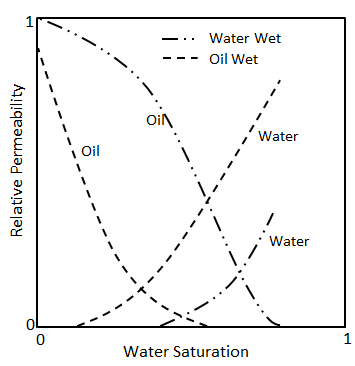Fundamentals of Fluid Flow in Porous Media
Chapter 2
Relative Permeability
Three Phase Relative Permeability: Relative Permeability in Two-Phase Systems
The wetting fluid in a uniformly wetted system is located in the smaller pores and as a thin film in the larger pores, while the non wetting phase is located in the centers of the larger pores. In general, at a given saturation, the relative permeability of a fluid is higher when it is the non wetting fluid In a water-oil system, as the system becomes more oil wet, relative permeability of water ( krw ) increases, relative permeability of oil ( kro ) decreases, and the cross-over point occurs at a lower water saturation ( see Figure 2‑85 )[1]. These special characteristics allowed Craig to generalize a few rules of thumb[1], which indicate the differences in the relative permeability of strongly water wet and strongly wet oil cores. These rules are presented in Table 1 below. Exceptions have been found to these rules, therefore wettability experiments should be performed separately to evaluate the wettability of the reservoir instead of relying only on Craig’s rules of thumb. Also, Craig’s rules of thumb can only distinguish water wet conditions from oil wet; they cannot identify the degree of wettability, or neutrally wet, fractionally wet or mixed wet conditions. Pore geometry can also have a strong effect on the measured relative permeability curves, affecting the cross over point in two-phase flow and the irreducible water saturation1. If the pore medium consists of a significant number of small pores, the irreducible water saturation is relatively large. Anderson has also mentioned the significant differences in Swc found in rocks with large, well interconnected pores compared to rocks containing smaller and less well connected pores. In the water wet cores, the smaller pores are filled with water, thus a larger number of small pores increases the irreducible water saturation, but if these pores are less well connected, the water flow is not better. When comparing these two samples, the rock with many smaller pores has a larger irreducible water saturation and the cross-over point for the relative permeability occurs at higher water saturation. [1] Anderson, W.G., “Wettability Literature Survey – Part 5: The Effects of Wettability on Relative Permeability”, SPE 16323. If you have any questions at all, please feel free to ask PERM! We are here to help the community.
Figure 2-85: Relative Permeability of Water Wet and Oil Wet Systems
Water wet
Oil wet
Swc
> 20-25 % of PV
< 10-15% of PV
Sw when krw = kro
> 50%
< 50%
krw at max Sw
< 30%
> 50% ( can be 100% )
References
Questions?
